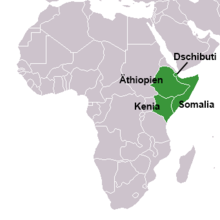Hunger crisis in the Horn of Africa in 2006
The 2006 Horn of Africa food crisis threatened according to estimate of the FAO in January 2006, about 11 million people - particularly ranchers - in northeast Kenya , South somalia , the south and east of Ethiopia and Djibouti . It was the result of drought and conflict (particularly the Somali civil war ) in the region. Later in 2006, floods occurred in parts of the same areas, which exacerbated the situation.
In July 2007, the Famine Early Warning Systems Network classified the situation in Ethiopia and Somalia as serious, that in Djibouti as critical and in Kenya as stable.
The term “famine” for the crisis in the Horn of Africa is - as in the case of the hunger crisis in Niger in 2005 - controversial, as it is less an acute famine than chronic malnutrition and a long-term crisis caused by drought, climate change, local environmental damage and conflicts act.
Causes and history
The last time drought and food shortages occurred in the Horn of Africa were 1999–2000. At that time, around 1.5 million people were affected and 98,000 people - mostly children under five years of age - died. The 2006 drought was classified by the FAO as the worst in the region since then.
Situation by country
Kenya
Overall, the food situation in Kenya was good at the end of 2005 after an overall above-average harvest. Above all in the cattle breeding areas in the north and east as well as in some arable areas in the south-east of the country, however, the rainfall during the short rainy season in November and December 2005 was low and reached just 30% of the average; this after the long rainy season of the same year had brought little rain. The drought led to livestock losses and crop failures. In December 2005, malnutrition rates of 18 to 30% were recorded in the most severely affected districts of Mandera, Wajir ( northeast region ) and Marsabit ( eastern region ). As of January 6, 2006, around 30 deaths from malnutrition had been reported and 2.5 million people, or 10% of the population, were considered to be in need of food aid for the next six months . President Mwai Kibaki declared a national emergency and asked the international community for US $ 150 million for food aid By July 2006, the long rainy season had set in and brought heavy rainfall. The food situation, especially in the districts of Moyale, Samburu, Turkana, Mandera and Marsabit, remained critical, and there was also an outbreak of diarrhea in Mandera, Marsabit, Garissa, Wajir, Isiolo and Samburu and measles in Wajir and Mandera. In January 2007 the same areas were hit by floods. International food aid has also been criticized, particularly in relation to Kenya. The hunger is not least a consequence of the corruption of the government, which is reinforced by outside help in not paying for the aid to those affected. In addition, food aid in north-east Kenya contributed to maintaining high livestock numbers and thus to overgrazing. Instead of short-term help, long-term food security and prevention should be promoted, for example through afforestation as protection against erosion.
Somalia
In Somalia, the number of people affected was estimated at two million. The "worst drought of the decade" led to crop failures in the arable areas in the south of the country, with estimates suggesting that the country lost 70% of its livestock. The Somali civil war , which began in 1991 , worsened the situation and made food aid difficult.
In mid-2007, the situation in southern Somalia remained critical after hundreds of thousands had been displaced by fighting in the state capital Mogadishu and the rainfall during the great rainy season Gu (April – June) was below average.
Ethiopia
According to the FAO, one million people were mainly dependent on food aid in the Somali region .
Djibouti
According to FAO estimates, 400,000 people, or a third of the population, were dependent on food aid.
swell
- FAO: Millions of people are on the brink of starvation in the Horn of Africa (Communication from January 6, 2006, English)
- UNICEF dossier on (Engl.)
- UN News Center: Governments, UN agree on 'road map' to tackle hunger in Horn of Africa
- BBC News: Drought hit Somalia's race against time

